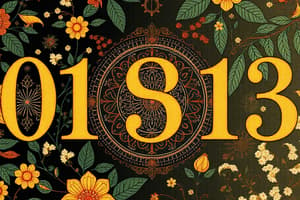Podcast
Questions and Answers
Which numbering system uses base 2?
Which numbering system uses base 2?
- Gray
- Hexadecimal
- Octal
- Binary (correct)
What is the primary purpose of BCD (Binary-Coded Decimal)?
What is the primary purpose of BCD (Binary-Coded Decimal)?
- To simplify data storage in text format
- To perform arithmetic operations more efficiently
- To represent decimal digits in binary format (correct)
- To convert binary numbers into hexadecimal
Which of the following is a characteristic of the Gray code?
Which of the following is a characteristic of the Gray code?
- Changes multiple bits between consecutive values
- Has a direct linear relationship with binary
- Only one bit changes between consecutive values (correct)
- Is primarily used for decimal representation
In which base does the octal numbering system operate?
In which base does the octal numbering system operate?
Which arithmetic operation is not commonly associated with hexadecimal numbering?
Which arithmetic operation is not commonly associated with hexadecimal numbering?
What is the main advantage of using Gray code in digital systems?
What is the main advantage of using Gray code in digital systems?
Which of the following binary arithmetic operations results in a carry bit?
Which of the following binary arithmetic operations results in a carry bit?
In which system is the value of '77' interpreted as decimal 63?
In which system is the value of '77' interpreted as decimal 63?
How does the conversion from binary to hexadecimal work?
How does the conversion from binary to hexadecimal work?
Which statement accurately describes BCD (Binary-Coded Decimal)?
Which statement accurately describes BCD (Binary-Coded Decimal)?
Flashcards
Binary Numbering System
Binary Numbering System
A numbering system that uses only two digits: 0 and 1.
Octal Numbering System
Octal Numbering System
A numbering system with base 8 using digits 0-7.
Hexadecimal Numbering System
Hexadecimal Numbering System
A base-16 system using 0-9 and A-F for digits.
BCD (Binary Coded Decimal)
BCD (Binary Coded Decimal)
Signup and view all the flashcards
Gray Code
Gray Code
Signup and view all the flashcards
What is binary?
What is binary?
Signup and view all the flashcards
Octal's base?
Octal's base?
Signup and view all the flashcards
Hexadecimal's range?
Hexadecimal's range?
Signup and view all the flashcards
BCD's purpose?
BCD's purpose?
Signup and view all the flashcards
Gray code's advantage?
Gray code's advantage?
Signup and view all the flashcards
Study Notes
Numbering Systems
-
Binary (Base-2): Uses only two digits, 0 and 1. Each digit represents a power of 2. Crucial in computer science due to its direct representation in digital circuits.
-
Octal (Base-8): Uses digits 0-7. Conversion to and from binary is straightforward (3 binary digits correspond to 1 octal digit). More compact than binary for representing larger numbers.
-
Hexadecimal (Base-16): Uses digits 0-9 and letters A-F. More compact than binary or octal, as 4 binary digits correspond to 1 hexadecimal digit. Commonly used in assembly language and computer memory addressing.
-
BCD (Binary Coded Decimal): Each decimal digit is represented by its 4-bit binary equivalent. Efficient for human readability (decimal output) but less efficient space-wise compared to other systems, as it takes 4 bits to represent a single decimal digit.
-
Gray Code: A non-weighted code where successive codes differ by only one bit. Useful for avoiding spurious errors in analog-to-digital conversion systems, where small changes can cause significant changes of multiple bit inputs in sequential readings.
Arithmetic Operations
-
Binary Addition: Similar to decimal addition, but carries are calculated using the rules of binary arithmetic.
-
Binary Subtraction: Performed by taking the two's complement of the subtrahend (the number being subtracted) and adding it to the minuend (the number from which we are subtracting).
- Two's complement is fundamental to binary subtraction allowing for simplicity in handling negative numbers with binary representations.
-
Binary Multiplication: Implemented through repeated addition based on the bits of the multiplier. Similar principles to decimal multiplication apply.
-
Octal/Hexadecimal Arithmetic: Calculations in these bases follow the same principles as in decimal and binary, but using the appropriate base-8 or base-16 rules for carries and borrowing.
-
BCD Arithmetic: Operations on BCD numbers involve binary addition and subtraction of the corresponding BCD representations, using corrections to maintain the BCD format and account for potential overflows. Example: if adding two BCD numbers that equal a result greater than 9, corrections are needed to avoid incorrect results. Carry propagation is usually involved.
Studying That Suits You
Use AI to generate personalized quizzes and flashcards to suit your learning preferences.
Description
This quiz explores various numbering systems including binary, octal, hexadecimal, BCD, and Gray code. Each system has its unique application and understanding them is crucial for computer science and digital electronics. Test your knowledge and see how well you grasp these fundamental concepts.



